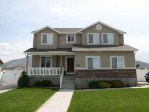Spanish Fork Utah Information
Information About Spanish Fork Utah
Schools
in Spanish Fork Utah
Facts
About Spanish Fork Utah
SOLD
Homes in Spanish Fork Utah
Information About Spanish Fork Utah
Bank Foreclosures and Short Sales in Spanish
Fork
Spanish Fork Utah General Information
Spanish Fork Utah Information: Spanish Fork City is the first city in Utah to provide high
speed internet and cable television to its local businesses
and residents. The city has a very proud heritage, as
evidenced by the many memorials located throughout the
community.
Largest Employer: Nebo School District: 2,371
employees State Rank by Population: 27 Political
Profile Out of the 8,752 registered voters, 7,192
cast ballots in the 2000 November election.
Spanish Fork is a city in Utah County, Utah.
It is part of the
Provo-Orem,
Utah Metropolitan Statistical Area. The
population was 35,659 as of the 2011 census.

Origin of Cities Name: Spanish Fork Utah
Spanish Fork was named after a river adjacent to the city's
original location, which was dubbed by the 1776
Dominguez-Escalante expedition. Date of Incorporation:
January 17, 1855
What is My Spanish Fork Utah Home Worth?
Spanish Fork Utah Information. Forget about guesses,
appraisals, dream prices, ineSpanish Forkperienced Realtors' opinions.
How about reality on what your Spanish Fork Utah Home is Worth? Our
service is fast, friendly, FREE and without obligation. We
will prepare a 10 page color report comparing your home to
similar sold homes in your neighborhood.
Spanish Fork Utah Information: History
Spanish Fork was settled by Mormon
pioneers in 1851. Its name derives from a visit
to the area by two Franciscan friars from Spain,
Franciso Atanasio dominguez and Silvestre Velez
de Escalante. They were in Spanish Fork in
1776. They were wandering down the Spanish Fork
canyon with the objective of opening a new trail
from Santa Fe, New Mexico to the Spanish
Missions in California, along a route later
followed by fur trappers. They described the
area inhabited by native Americans as having
"spreading meadows, where there is sufficient
irrigable land for two good settlements. Over
and above these finest of advantages, it has
plenty of firewood and timber in the adjacent
sierra which surrounds its many sheltered spots,
waters, and pasturages, for raising cattle and
sheep and horses".
In 1851 some settlers led by William Pace set
up scattered farms in the Spanish Fork bottom
lands and called the area the Upper Settlement. However a larger group congregated at what
became known as the Lower Settlement just over a
mile north-west of the present center of Spanish
Fork along the Spanish Fork River. In December
1851 Stephen Markham became the branch president
of the LDS (Mormon) settlers at this location.
In 1852 Latter-day Saints founded a
settlement called Palmyra west of the historic
center of Spanish Fork. The LDS Prophet
George A. Smith supervised the laying out of a
townsite, including a temple square in 1852.
A fort was built at this site. A school was
built at Palmyra in 1852. With the onset
of the Walker War in 1853 most of the farmers in
the region who were not yet in the fort moved
in. Some of the people did not like this
site and so moved to a site at the mouth of
Spanish Fork Canyon where they built a structure
they called "Fort St. Luke". Also in 1854
there was a fort founded about two miles (3 km)
south of the center of Spanish Fork that latter
was known as the "Old Fort".
In 1856 Brigham Young advised leaving the
Palmyra site because of its swampiness and the
high alkali content of the soil. At this time
the settlers relocated to Spanish Fork and began
to build its current center. John L.
Butler became the first bishop of the Spanish
Fork Ward at this time.
Between 1855 and 1860, the arrival of
pioneers from Iceland made Spanish Fork into the
first permanent Icelandic settlement in the
United States. The city of Spanish Fork
has erected a monument to honor the Scandinavian
settlers in Spanish Fork. The city also
lent its name to the 1865 Treaty of Spanish
Fork, where the Indian tribe the Utes were
forced by an Executive Order of Abraham Lincoln
to relocate to the Uintah Basin. In 1891
the Spanish Fork Ward was divided into two
wards. By 1930 there were five Spanish Fork
Wards plus the Palmyra Ward which had been
established at the location of the old
settlement in 1901.
Search Spanish Fork Homes for Sale
Spanish Fork Utah Information - Homes for Sale. Search
Spanish Fork
Utah
Bank Foreclosures and Spanish Fork Utah Short Sales for Sale.
Hire a local Spanish Fork Utah Realtor. Click the "Map Search" below
and see an instant list of all the available homes for sale
in Spanish Fork Utah. Hire a
Spanish Fork Utah
Townhomes.


